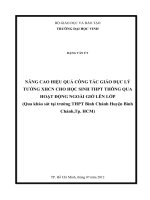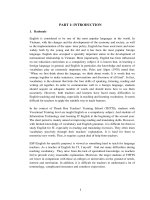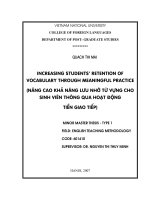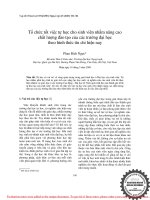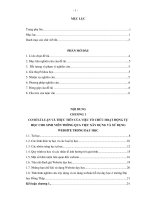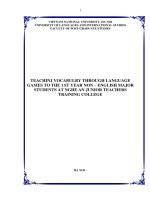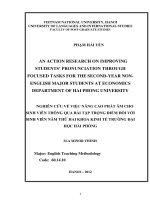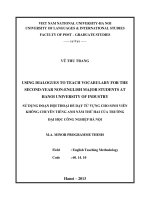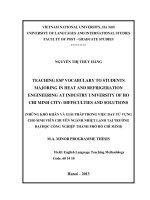nâng cao khả năng lưu nhớ từ vựng cho sinh viên thông qua hoạt động tiền giao tiếp
Bạn đang xem bản rút gọn của tài liệu. Xem và tải ngay bản đầy đủ của tài liệu tại đây (443.68 KB, 58 trang )
!"#$%&
'()
! " #
$%&'()"
*
!
"#$
%
&'($
" ) # *
* +
,
!
- . -
/ , /
0 1 /
2 /
3 45 0
"!
$%,&6.7"6.,*.6.6#6! 2
- 2
-- 2
-/!8 2
-/- 3
-// 9
-/0( 9
-/2$ :
/ ; :
/-"' :
/-- :
/-/"< =
/-0" >
// ' -?
//- -?
///1
/0" -/
/0-" -/
/0/" -0
0 ; -2
0-( < -9
0/* -:
$%,&6.7%61*@
- -=
/ .;' ->
0 & ->
0-& /?
0/ /?
2& /-
2- /-
2/ //
3. //
3-.' /0
3/.' /=
30Comparison of mean scores and t-scores of the 2 tests of the two groups
00
-1A 03
/" 03
0$ 09
0=
!!#$% &'( )
!!#*%+, -.,( )
+, , !
- .' /0
/ $ ' /2
0 &'; /2
2 ' /9
3 ' /:
9 .' /=
: $ '
/>
= &'; />
> ' 0-
-? ' 0/
$ ' / /
00
-/ $1''
/
,/
Table 13
'/ 00
#
'
' <
6 7 +
* & *, +
*- * * - -*
( * *-, + + .+ -
&
;'
5&1''
INTRODUCTION
1. Rationale
Vocabulary is an important language element that links four language skills of listening,
speaking, reading and writing together and makes communication flow smoothly. Reality
shows that many students have fairly good knowledge of grammar but are hardly able to
express themselves properly because of their vocabulary deficiency. Vocabulary learning,
therefore, becomes central to language acquisition, and interest in its role in second language
learning has grown rapidly in recent years. Specialists now emphasize the need of systematic
and principled approach to vocabulary by both the teacher and the learner (Decarrico, 2001;
Nation, 1990). One of the concerns in vocabulary is how to help students increase their
retention of learned vocabulary items.
Many Vietnamese students experience considerable difficulty retaining English words that
they have learnt in their previous lessons. Long lists of words noted down from reading texts,
listening passages, vocabulary or grammar sections in the course books are of limited help to
them if they do not know how to learn, remember and use these words. That most words
which have been learnt are forgotten soon and then become dead is one of the reasons for
students’ difficulty in communication, both in the oral and written forms.
To ensure a good communicative task performance, the ground work is to ascertain a good
lead-up and preparation for learners’ intake of vocabulary. So far there has been little
empirical evidence about the effectiveness of meaningful practice in vocabulary retention, so
whether meaningful practice increases students’ retention of vocabulary during the teaching
and learning process is the question that the author tries to answer.
Retention is defined as “an ability to recall or recognize what has been learnt or experienced;
memory” (Oxford Advanced Learner’s Dictionary. Oxford University Press, 1992:773).
Although I have not found any definition of vocabulary retention in the literature, I, for the
purpose of this study, can define it as the “storage of vocabulary in the memory, which
becomes available for use when needed”. So retention of vocabulary is the ability to recall
words that have been learnt or encountered for online communication .
2. Aims of the study
Given the role of vocabulary retention in helping students to communicate more effectively in
English, I set out the aim of this study as to find out techniques or activities that can help ma\y
students to memorize words better. These students are non-English major ones and have four
class meetings a week. However, they cannot retrieve the words which they have learnt in
previous lessons for online communication when needed. In other words, they soon forget
words they have just acquired. The main aim of this study therefore is to investigate the
impact of meaningful practice on vocabulary learning and retention, or to put it
differently, the extent to which meaningful practice helps to retain vocabulary for my
students at the university and provide some teaching implications.
3. Scope of the study
There is a wide range of language activities which can be used to improve students’ retention
of vocabulary. However, in the current study, I set the limit of investigating the impact of two
meaningful activities of guessing new words through context and using dictionary on students’
learning and retention of English vocabulary because with the timeframe of 12 weeks it is
supposed to be infeasible to conduct a research study on a larger scale which can produce very
convincing results.
Participants in this study were non-English major second year students of Hanoi University of
Business and Technology who were considered at the intermediate level of English and
working with Business English course book “Business Objectives” by Vicki Hollet. This study
was implemented amongst 2 groups which included 4 intact classes with 111 students
altogether for a duration of three months.
4. Method of the study
This study was conducted by quasi-experimental method with 2 classes of the experimental
group and two classes of the control group . It was quasi-experimental because the students
of the experimental group and the control group were not randomly assigned, and therefore
were not of equal proficiency levels of English. In fact, they were intact groups (Wiersma,
1995). The duration of the experiment was 12 weeks and 2 vocabulary tests were administered
to measure students’ retention of vocabulary. The results of the tests were analyzed by using
Paired Samples T-test to find out the gain for each group and Independent t-test to compare
the gains of the two groups.
5. Organization of thesis
This thesis is comprised of three parts.
Part 1 is the introduction which presents the rationale for the research topic, aims, scope, and
method of the study.
Part 2 is the development which consists of two chapters. Chapter one reviews theoretical
background to teaching and learning vocabulary in a second language including factors which
affect vocabulary acquisition process. This chapter also reviews some meaningful practice
activities which are initiated by different researchers. Chapter two reports the study in terms of
data collection and analysis.
Part 3 is the conclusion which discusses the major findings and limitations of the research, and
suggests teaching implications for further study.
DEVELOPMENT
CHAPTER I: LITERATURE REVIEW
1 The importance of vocabulary in second language learning
1.1 The importance of vocabulary in second language learning
In order to progress in foreign language learning, learners need to be able to understand what
they are encountered with I verbal communication, that is they need to acquire a certain
amount of words. In the very first part of his book on vocabulary, McCarthy (2000:2) wrote:
“It is the experience of most language teachers that the single, biggest component of any
language course is vocabulary. No matter how well the student learn grammar, no matter how
successfully sounds of L2 are mastered, without words to express the wide range of meaning,
communication in an L2 just cannot happen in any meaningful way”.
This claim might be an overestimate of the role of vocabulary, and many language teachers
can argue that an appropriate way of communication is far more important than words, or in
other words, HOW we say something is more important than WHAT we say. However, one’s
communication ability in general depends a lot on his/her vocabulary size, because “words are
the tools we use to think, to express ideas and feelings, and to learn about the world” (Johnson
and Johnson, 2004:1), to communicate about something very concrete to something very
abstract.
The support for the important role of vocabulary can be found in works of Nation and Coady
(1988), Gu (1994), Nassaji (2003) and Alexander (2000). In her book “Understanding
Vocabulary” (2000:16), Alexander wrote: “Comprehension improves when you know what
the words mean” and “words are the currency of communication. A robust vocabulary
improves all areas of communication — listening, speaking, reading and writing”. These all
show that the success of a student in becoming proficient in any language depends in part on
the extent and richness of his/ her vocabulary, so vocabulary teaching should be part of the
syllabus, and vocabulary should be taught on a well-planned and regular basis.
1.2 What it means to know words?
“The main problem with vocabulary teaching is that only a few words and a small part of what
is required to know a word can be dealt with at any one time” (Nation, 2005). Only a small
amount of information about a word is presented and acquired at a teaching time. This
limitation apparently has negative effects on learners’ vocabulary knowledge. In many
situations they can recognize a word when it is written but do not know how to pronounce it
correctly, or vice verse; and even when they have a word in mind they do not know how to use
it properly. Knowledge of a word is not just restricted to knowing its single meaning but this
requires comprehension of the word form, meaning, grammar and collocation… so that the
language learners can generate it for their need. However, which aspects of these should be
focused on during the teaching and learning process depends on the target learners’ schemata
and learning burden.
1.2.1 Form
Words come in two forms: oral and written. The former refers to the word’s pronunciation
whereas the latter refers to the word’s spelling. “Unfamiliarity with correct pronunciation can
result in the learner failing to understand words in connected speech that he clearly
understands in written English” (Gairns and Redman, 1986:50); therefore, when introducing
new words to language learners, the teacher should pay careful attention to both of these forms
and provide them with certain general guidelines that will assist them in predicting the
pronunciation of new lexis. For example, there are letters and spelling which usually conform
to a particular pronunciation, e.g. au / :/ in because, automobile, automatic; a /æ/ in happy,
sack, parent; sh / / in wash, English, sharing… . However, there are so many exceptions in
English pronunciation (Swan,1980; Gimson and Ramsaran,1982). The complex relationship
between sound and spelling in English makes it really difficult for foreign language learners
to tackle the pronunciation of new vocabulary. Thus, alongside with introducing general
guidelines, the teacher should also provide fairly specific rules for English pronunciation.
Nation (2005) recommends quick ways of drawing attention to the form of the word , e.g.(a)
writing the word on the board, (b) showing how the spelling of the word is like or unlike the
spelling of known words, (c) giving stress pattern of the word and its pronunciation, (d)
getting the learners to repeat the pronunciation of the word, and (e) pointing out any spelling
irregularity in the word.
1.2.2 Meaning
With regard to the meaning of a word, Diamond and Gutlohn, (2006:1) claim that: it “not only
implies a definition, but also implies how that word fits into the world." This means that
besides its core meaning in the particular context that students are working out, the word
should be introduced to the learners in different discourse contexts so that they can gradually
comprehend all aspects of its meaning.
There are two types of word meaning: lexical and grammatical meaning. Lexical meaning
gives meaning of the words. Grammatical meaning is the functions of a word in relation with
other words with which it is used. Participles, articles and/or preposition are usually used with
their grammatical meaning. Cities are big (1) differs from The cities are big (2) by the article
the. The first sentence gives information of all cities in general whereas the second sentence
talks about some certain cities that are identified by both of the speaker and listener. If the
word the stands alone it gives no information at all, but when combined with other words in
sentence (2) it carries very important meaning.
That which meaning(s) of a word should be introduced to students at a teaching time depends
on students’ need and their language background knowledge. The teacher has to balance the
amount of time spent on meaning-focused input and meaning-focused output so that he/she
can both guide his/her students to get the meaning of the words correctly and get them
involved in a process of semantic processing that facilitates learning and retention.
1.2.3 Grammar and word formation
Learning grammar of vocabulary is learning the rules that enable students to build up different
forms of a word or even different words from that word (e.g. sleep, slept, sleeping; employ,
employed, employment, unemployment, employer, employable…). When students learn about
the parts of words, prefixes and suffixes, and about root words, they are able to table out many
new words. Grammatical patterns of a word helps learners to recognize whether it suits the
language situation or not, and use it correctly. When students are given a task that requires
them to use the correct tense of a verb, they have to utilize their knowledge of grammar to
fulfil the task. Correct grammar of words helps to function better their pragmatic use and
convey message clearer in communication.
1.2.4 Collocation
The relationship of collocation according to McCarthy (1990: 12) is fundamental in the study
of vocabulary. Collocation is defined as “the way in which some words are always used
together, or a particular combination of words used in this way”, for example: commit a crime,
for the sake of, accept responsibility…
Hill (1999) explains that many learners with ‘good vocabularies’ have problems with fluency
because their ‘collocational competence’ is very limited. Collocational competence is the
ability to accurately combine chunks of language thus enabling production of fluent, accurate,
and stylistically appropriate speech. Lewis (2000) asserts that about 70% of English language
is made up of these chunks of lexicon that co-occur together in order to produce natural
sounding language. For example, when students encounter the word “risk”, they should be
introduced the whole chunk “take a risk”. From intermediate level, teaching should aim at
increasing students’ collocational competence, both inside and outside the classroom.
2. Factors affecting vocabulary acquisition
2.1 Learner-related factors
2.1.1 Memory and storage system
An important part of learning is the storage of what has been learned in the long- tem memory.
The human mind effectively has three kinds of memory: sensory memory, short-term memory
(or working memory), and long-term memory (Peet,2003:3). Sensory memory has the capacity
to hold a limited number of items for a period of only a few seconds, for immediate tasks that
require little or no processing, such as remembering a phone number long enough to dial it, or
a word long enough to repeat it. Our short-term memory, in contrast, retains items for up to
twenty seconds, and is used in circumstances where information needs to be manipulated or
processed at a deeper level. Actually, short-term memory is a controlled processing procedure
at which the learner can retrieve their newly knowledge with effort. Finally, there is our long-
term memory, which has the ability to store items away indefinitely. This is an automatic
processing procedure that ensures retrieval without effort.
So, learning new items involves storing them first in our short-term memory, and afterwards in
long-term memory. However, our long-term memory can hold any amount of information
because it is highly organised and that semantic related items are stored together so once the
words are stockpiled in long-term memory storage, it can be taken back for use easily.
Information is transferred from short-term to long-term memory basing on the principle of
seeing – hearing – touching – saying, so after a word is presented to students, it should be met
again and again in different discourse contexts, whether visually or orally so that it can
gradually be picked up into the learners’ mind. In the condition of limited natural language
exposures for foreign language learning in Vietnam, classroom activities (such as repetition,
pair work and group work, peer testing, sentence making or presentation contests, doing cross-
word…) and autonomous learning (mainly reading, self testing, using stick- notes and
dictionaries… ) are of effective application. However, “human memory works most efficiently
when it deals with structured information rather than a port-pourri of facts and information.”
(Katamba, 1994:229), so these activities and materials should be constructed in a systematic
procedure to present a selection of connected words for easy storage.
2.1.2 Learners’ needs and interests
A lexical item is most likely to be learned when it is relevant to a learner’s need to know it or
use it to accomplish his/her communicative purposes. Therefore, the decision to incorporate a
word in one’s productive vocabulary is entirely personal and varies according to each
student’s motivation and needs.
In many cases the teacher decides what words should be taught to his/her students because
he/she is more experienced in language use and often knows what is better for a learner.
However, it is important for teachers to be sensitive to the learner’ needs (Peet, 2000:2) and it
is a good idea to let the learners decide what words should be of more attention. In other
words, when learners encounter a soar of words in their course book, they have the right to
decide on the number of words that they really need to learn and make use of either for
receptive or productive purposes. Vocabulary building and using activities should be therefore
interesting to the students and offer them opportunities to use both the newly and previously
acquired vocabulary.
2.1.3 Learning styles and strategies
Learning style is the individual’s habitual and preferred way “in which individual
characteristically acquires, retains, and retrieves information” (Felder & Henriques, 1995:21)
and is influential in a learner’s process of language acquisition. According to Felder
(1995:22), learning styles are categorized into different dimensions depending on the students’
preferential perception (sensing, intuitive, verbal and visual), their information process
(active, reflective) or understanding of materials (sequential, global, inductive, and reductive).
Learning styles are important to a learner’s process of language acquisition and each type of
learners can employ effectively more than one ( or a mixture of many) learning style(s).
Learning strategies are “specific actions, behaviours, steps, or techniques that students (often
intentionally) use to improve their progress in developing L2 skills. These strategies can
facilitate the internalization, storage, retrieval, or use of the new language” (Oxford,
1992/1993:18 cited in Lessard-Clouston, 1997). In other words, learning strategies are the
characteristics or behaviours we want to stimulate in students to help them become more
proficient language learners, so, strategies are tools for the self-directed involvement
necessary for developing language ability in general and vocabulary ability in particular.
There are many different language learning strategies (LLS) which can be employed in
vocabulary development. Oxford (1990b:71) has distinguished LLS into 6 groups: memory,
cognitive, compensation strategies (these go to direct strategies) and metacognitive, affective,
and social strategies (these are indirect strategies) whereas Nation and Newton (1997:240)
identified strategies for coping with and learning words as “guessing from the context, using
word parts to help remember word meanings, and using mnemonic and rote vocabulary
strategies”. In relation to vocabulary learning strategies, O'Malley and Chamot (1990)
distinguished cognitive (e.g., translating, analyzing) and metacognitive (e.g., planning,
organizing) strategies. Each scholar has his/her own point of view in grouping learning
strategies basing on results of their research from a certain type of language learners, but it is
clearly seen that when a learner consciously chooses strategies that fit his or her learning style
and the L2 task at hand, these strategies become a useful toolkit for active and purposeful self-
regulation of learning.
There is no utmost effective learning style or single best strategy for all learners learning
foreign language vocabulary. Effectiveness of learning is not constrained to just one or two
strategies. A good language learner uses many different learning strategies, then employs and
individualizes the ones that are workable and applicable to them when performing specific
tasks.
2.2 Teacher-related factors
2.2.1 Teaching method
The history of second language teaching has experienced many teaching methods and
approaches: grammar – translation, direct, reading, audio-lingual, community language
learning, the silent way, total physical response, and communicative - each of which aims at
improving learners’ certain language skill. Grammar-translation method, community language
learning, and communicative approach work well with language learners whose natural
language exposure is limited (Moras, 2002)
However, there is no absolute answer to the question: "what is the best way to teach
vocabulary?" because the results of teaching and learning process are affected by not only the
teacher’s teaching method, the learners’ learning styles and strategies but also many other
factors beyond language education such as personality, intelligence, aptitude, attitude,
motivation, age… of the particular group of students (Lightbown & Spada, 1999:49). In terms
of vocabulary, learners need multiple encounters with words (Hulstijn, 1992; Folse, 1999);
thus, the most important point in teaching and learning vocabulary is the number of times the
learner has to retrieve the word - a factor which the teacher can influence through classroom
activities.
Vocabulary is acquired incidentally but it should be taught systematically and intentionally,
especially in foreign language environments where learners have limited exposure to the
language outside of the classroom as in Vietnam. What words to teach and how to teach them
effectively depends on the teacher’s understanding of his/ her particular learners: what type of
learners they are, what language environment they are in, what their needs and interests are…
The theories of comprehensible input and affective filter by Krashen (1982/1985) in
language acquisition should be taken into account in deciding what words and how many
words to teach in each class meeting. According to the former hypothesis, the learner
improves and progresses along the 'natural order' when he/she receives second language 'input'
that is one step beyond his/her current stage of linguistic competence ( what Krashen calls “i +
1”). Since not all of the learners can be at the same level of linguistic competence at the same
time, Krashen suggests that natural communicative input is the key to designing a syllabus,
ensuring in this way that each learner will receive some 'i + 1' input that is appropriate for
his/her current stage of linguistic competence. The latter hypothesis refers to the learner’s state
of mind and disposition such as motives, needs, attitudes, emotion… which prevents learners
from acquiring language from the available input. The teacher’s understanding of these
hypotheses in cooperation with applying suitable teaching methods will bring about success to
classroom practice and make the process of learning new vocabulary fun and enjoyable.
2.2.2 Strategy training
It has been suggested that strategy training may help learners in three ways: firstly, it can help
students to become better learners; secondly, skill in using learning strategies assists them in
becoming independent and confident learners; and finally, they become more motivated as
they begin to understand the relationship between their use of strategies and success in
learning languages (Chamot & Kupper, 1989; Chamot & O'Malley, 1994). Learners should be
taught not only about learning strategies but also about when to use them and how to use them,
or in other words, to be instructed on how to choose the best and most appropriate strategy in a
given situation. According to Chamot and O'Malley, using a combination of strategies often
has more impact than single strategies. Also, they need to know how to use a combination of
strategies that work well together to adapt to the requirements of each language task because
certain strategies or clusters of strategies are linked to particular language skills or tasks. With
regard to vocabulary learning, research shows that for most adult learners (and university
students are considered to be adult learners), direct vocabulary instruction is beneficial and
necessary, due to the fact that students are not able to acquire the mass of vocabulary just by
meaningful reading, listening, speaking and writing. Learners can be taught explicitly how to
improve their own vocabulary by teaching them appropriate vocabulary learning strategies in
contrast to simply letting them learn vocabulary in their own way (Brown & Perry, 1991).
Ellis (1985) notes that we should remember that vocabulary learning also involves the use of
individual learning techniques. He has also found that vocabulary learning techniques and
strategies enhance understanding of the acquisition processes in the learners' mind. Therefore,
a description of vocabulary learning strategies can be used as a guideline to help learners in
their lexical acquisition (Ellis, 1995). Strategy training can be embedded in new word
presentation or classroom practice activities to make the learning flexible.
2.3 Learning context
Many learning theories describe learning as an interaction between the learner and a situation
within the context of a community which involves many things such as learners’ needs,
learning content, teaching and learning materials, classroom activities and physical
environment (with or without technology assistance)… but in the range of this study the
author would like to take into consideration just two factors of the context that directly relate
to the result of the learning process: language input and language output.
2.3.1 Language input
In order to progress in a foreign language, learners need to be able to understand what they are
hearing and reading. That is, the input must be comprehensible in order for it to be useful and
meaningful to the learner and help with acquisition (Krashen, 1982). If learners do not
understand a sizable portion of the vocabulary in the language that they are reading or hearing,
then this language is not comprehensible and therefore cannot be useful for acquisition (Folse,
2005:6).
According to Krashen (1982/ 1985), second language is most successfully acquired when the
conditions are similar to those present in first language acquisition: that is, when focus is on
meaning rather than on form; when language input is at or just above the proficiency level of
the learner; and when there is sufficient opportunity to engage in meaningful use of that
language. This suggests that the focus of the second language classroom should be on
something meaningful, which is then processed in the learners’ mind, and that modification of
the target language facilitates language acquisition. For example, when the second- year
business-major students are introduced the topic “company”, they will be able to learn and use
lexical items of headquarters, turnover, staff turnover, company strengths, running costs,
subsidiary, take risk …, not vasectomy, molar, infections, uterine, complications, ectopic
pregnancy, tease out… because the latter items do not belong to their professional background
knowledge but to medical students’ in gynecology and business students do not have
opportunities to engage these words in meaningful use.
English language learners in Vietnam do not have an adequate natural language environment
to practice language skills that they have learnt or acquired. This limitation actually hinders
their language development; thus, when being in a real contact with the target language our
students produce very low reaction in bookish style. This raises the necessity of providing
students with opportunities and language activities to use the target language extensively
through practice, games, presentations, and eloquence contest.
In addition to the amount of exposure, word frequency is another factor that affects storage, as
the most frequently used items are easier to retrieve. There is great improvement in vocabulary
retention when students encounter learnt words often (National Reading Panel, 2000) to place
it firmly in their long-term memories. This does not mean mere repetition or drill of the word
but seeing the word in different and multiple contexts. In other words, useful vocabulary needs
to be recycled and used again and again, in more than one context, so that too much forgetting
does not occur.
*/*0
Input alone cannot directly affect the language development if students do not have
opportunities to use the target language productively. Output brings about mental process of
learning. Swain (1985) first proposed the ‘comprehensible output hypothesis’ in response to
Krashen’s comprehensible input hypothesis, based on the observation that French immersion
students were considerably weaker in their speaking and writing production than in their
reading and listening comprehension. She advocated more opportunities for learners to engage
in verbal production, i.e. output. Similarly, the results of Izumi & Bigelow’s research (2000)
on the effect of output on L2 vocabulary indicated that participants in the with output groups
outperformed the non-output and the control groups on post-test measures.
Logically, language production depends on the learners’ motivation, needs and vocabulary
size and “it is not a syntactic rule-governed process but is instead the retrieval of larger phrasal
units from memory” (Canh, 2004: 18) We acquire and retain our vocabulary through seeing,
hearing and saying the words numerous times in many contexts then producing messages in
communication. Native speakers get hold of words incidentally and easily because they
encounter them minutely in the speech and writing of other people. Foreign language learners
do not have such submersion environment so they have to make use of every chance to
“touch” the words. Steele (2005) justifies that words are learnt by individual, but through
memorable presentation, personalization tasks, so how lexicon is presented and activities are
conducted in the class for practice is very important in anchoring new words into students’
memory (Hulstijin: 1997), especially when they do not have advantageous language
environment outside the classroom. In this case, classroom practice embeds both input and
output resources for the learners.
Remembering words involves putting words in storage, keeping them in storage, retrieving,
and using them. There are many types of practice activities that help students to work with
vocabulary learnt: mechanical, meaningful, communicative… and each of these is applied to
get a certain set of learning goals. Since meaningful practice is the focus of this study, a more
detailed discussion on this topic will be addressed in the part below.
3. Meaningful practice and vocabulary acquisition and retention
Practice has a wide variety of advantages. Firstly, it involves learners in working together and
helping each others on the meaning of unfamiliar language, including new vocabulary items.
(Nation and Newton,1997:244). This is a good chance for learners to be exposed to repeated
use of the new items during the course of activity that serves to generate better input.
Secondly, it provides a learning environment in which learners can make errors and express
their understanding or misunderstanding without the fear or shame of exposing their weakness
to the superiors. This is a very good chance for the learners to actively make any adjustment
or clarification to make input and output comprehensible. Thirdly, through negotiation,
learners can sharpen the word after initial input by getting additional information for the
known words, and therefore, avoid forgetting and automize the existing knowledge (Moras:
2001). Brown (2000:83-84) describes meaningful practice as “a process of relating and
anchoring new material to relevant established entities in cognitive structures”. That is,
meaningful practice is the practice with teacher’s guide aiming at increasing student’s
retention and fluency development. Wilkins (1976) has defined meaningful practice as one
where the student has to understand part or all of the sentence in order to be able to respond to
it. With regard to meaningful practice, Hubbard, et al. (1983) state that it is possible for
practice to be meaningful and yet highly artificial, it helps students to produce what they want
to say using the lexical items introduced in the class and serves as a lead-in for communicative
task.
Gairns and Redman (1986) assert that meaningful practice has a variety of advantages. Firstly,
the students have the means to perform the learning task, otherwise they will become
frustrated and lose motivation. Secondly, it enables students to be more-reliant because
vocabulary consists of single words, sets of phrases, variable phrases, phrasal verbs, and
idioms so once students have performed their learning tasks frequently, the possibility of
retrieving these lexical items successfully for online communication will be very high.
Thirdly, it requires learners to analyse and process language more deeply, which should help
them retain information stored in long-term memory and take back from memory as a whole,
reducing difficulties. Learners who only learn individual words and do not have opportunity to
employ meaningful practice before joining real-life interactional communication will need a
lot more time and effort to express themselves.
Meaningful practice can be applied through many classroom activities as guessing meaning of
vocabulary items from the context, working with dictionaries, noticing and recording
language patterns and collocations, repetition, first and second language translation…. Each
practice activity relates to a relevant learning strategy that helps the learners process message
content and test out hypotheses about the target language learning manner (Swain, 1995 in
Ellis, 2000). Below are two of the tasks that are well documented in the literature.
3.1. Guessing words through context and students’ schemata
Guessing words is one of strategies for vocabulary development and can be used as a
meaningful practice in the classroom as well. It is mainly used in reading comprehension or
online conversations in which there are clues or contexts for communicators to discover the
meaning of the unknown words encountered. Read (2000:47) found evidence for his
hypothesis that “the amount of mental effort that the learners put into understanding an
unknown word would positively influence their chances of retaining its meaning”. His study
discovered that when students had to work out the meaning themselves, they remembered it
better than if they were simply given a synonym or translation. The teacher has to train his/her
students in identifying contextual clues available and making guesses the meaning of unknown
words. Whenever a guessable word occurs, the teacher trains the learner in the strategy of
guessing from context. Contextual guesswork means making use of the context in which the
word appears to derive its meaning. Clues for guessing may be in the surrounding words. The
discourse may provide a definition that explains the unfamiliar word, or it may give an
example to illustrate the unfamiliar word. There may be connecting words used after the
unfamiliar word that indicate the similarity or contrast. Knowledge of word formation, e.g.
prefixes and suffixes, can also help guide students to discover meaning (Read, 2000:53).
Teachers can help students with specific techniques and practice in contextual guesswork, for
example, the understanding of discourse markers and the identifying of the function of the
word in the sentence (e.g. verb, adjective, noun) or the interlocutor’s intonation, facial
expressions, pitch and tone of the message flow in an online communication. For example, in
unit 10 of the course book “Business Objectives” by Vikki Hollett (1996:101), in the
Chairman’s review of activities and operations, she wrote; “We have established a new
wholly-owned subsidiary”. With the teacher’s guidance in analyzing word formation, students
can practice to guess the meaning of the new words wholly-owned subsidiary; Or in a
presentation about company restructuring, students come across with the word natural
wastage. By finding and basing on immediate clues of the surrounding facts and tables:
Natural wastage: resigned= 12; retired=4; early retirement=8
Other reductions: redundancies = 26; transferred = 30; dismissed = 0
the students can guess the meaning of the unknown word.
Though, in many cases, there are no immediate clues for the unknown words, the success of
guessing works depends a lot on the students’ background knowledge about the topic (or
general schemata), core vocabulary size, and personal experience. While doing the
guesswork, the guessers have to search their mental store to do the task, so it is a chance for
them to recycle their known words as well. In order to conduct this practice successfully, the
teacher should know about students’ schemata, discover the linguistic gaps in their knowledge
so that he can help them activate their existing knowledge of vocabulary and absorb new ones.
Now students are involved in a process of semantic processing that helps learning and
memorizing. However, this deduction can lead to imprecision and misrecognition. To
overcome these problems, learners need to have a well-developed core vocabulary, a stock of
good deduction skills, and some prior familiarity with the subject matter of the discourse. If
the context for guessing is global, that is too difficult for learners to work out the meaning of
the unknown words, so using dictionary is another recommendation for practice.
3.2 Using dictionary
Using dictionaries should be the main ways to deal with discovering meaning in cases that
language learners do not have or are not fully aware of the language context of the words
encountered. With adequate training, dictionaries are a valuable tool for learners, giving them
independence from the teacher. As well as understanding meaning, students are able to check
pronunciation, the grammar of the word (e.g. verb patterns, verb forms, plurality,
comparatives, etc.), different spelling (American versus British), style and register, as well as
examples that illustrate usage. Dictionary use teaches students about multiple word meanings
